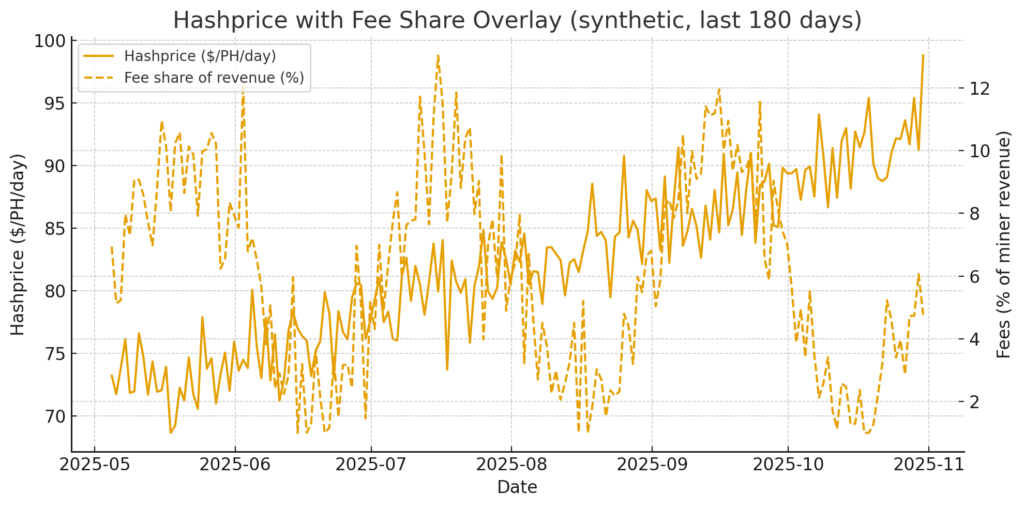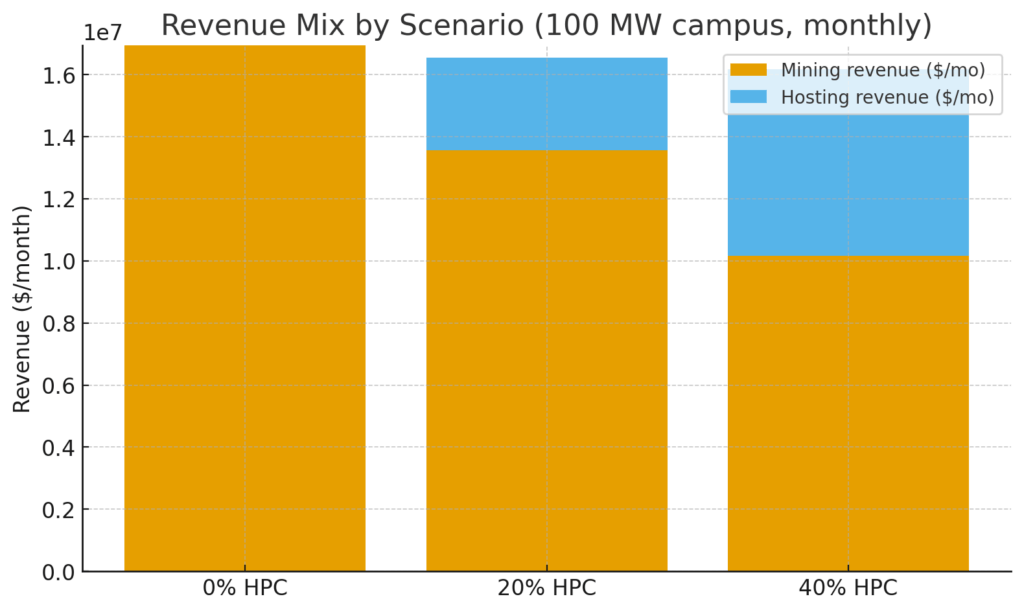Bitcoin (BTC) April 2024 minimize block reward might be halved from 6.25 BTC to three.125 BTC, compressing hash costs and forcing Bitcoin miners to rethink their enterprise fashions.
As an alternative of ready for the price market to rescue margins, the most important operators have begun signing offers to lease infrastructure to AI tenants.
Core Scientific has dedicated to provide 500 megawatts of energy to CoreWeave for $8.7 billion over 12 years. Cipher locked in 168 MW with Fluidstack for $3 billion over 10 years with Google’s backstop obligations.
These offers are primarily based on the calculation that the identical inputs that energy SHA-256 ASICs can generate extra income per megawatt-hour if they’re directed towards high-performance computing.
The query is how a lot non-Bitcoin income miners might want to relieve promoting stress on authorities bonds, what’s going to occur to the community’s hashrate as capability shifts, and which operators have the stability sheets to carry out.
Bitcoin miners management every part wanted for AI computing, together with low-cost electrical energy, industrial land, cooling infrastructure, and operational experience.
The income curves are totally different. Mining ties income to hash value and coin value. AI colocation delivers contracted greenback income per kilowatt month. What issues is the margin comparability in {dollars} per megawatt hour, and when the hash value is compressed, the unit economics favor internet hosting.
Safety budgets underneath stress
Hashprice measures a miner’s income per petahash per day. When it falls, miners shut down their machines or promote their Bitcoins to cowl authorized prices.
The community’s safety finances is equal to dam subsidies plus charges in Bitcoin phrases, however its greenback worth has grow to be extra risky for the reason that halving.
A brief spike in charges when Runes launched throughout the halving block confirmed how on-chain demand can impression hash costs, however outdoors of these spikes, charges have been modest.

Electrical energy costs are fastened in {dollars} and earnings are earned in Bitcoin. If hash costs stay at $50 per petahash per day, a contemporary fleet of Antminer S21 class machines working at 17.5 joules per terahash will generate roughly $119 per megawatt hour.
After subtracting the $50 per MWh electrical energy value, the money margin is $69 per MWh. The mannequin is operational, however simply barely.
In the event you enhance the hash value to $75 per petahash per day, the income will increase to $179 per MWh, providing you with a money revenue of $129 per MWh.
The distinction between survival and profitability is slim and will depend on elements outdoors the miner’s management, comparable to BTC value, community problem, and price velocity.
AI internet hosting makes use of the identical infrastructure that runs ASICs and presents an answer with dollar-denominated contracts that don’t fluctuate with hash costs and are locked in over a number of years.
The place Bitcoin miners meet AI
Bitcoin miners and AI operators require the identical infrastructure, together with inexpensive energy, proximity to substations, industrial cooling, fiber optic interconnects, and experience to keep up uptime.
Core Scientific’s CoreWeave contract prices about $121 per kilowatt for internet hosting. Cipher’s Fluidstack contract prices roughly $149 per kW per thirty days.
These are contracts signed with creditworthy counterparties and will not be formidable projections. The income construction usually separates internet hosting charges and energy prices, because the tenant reimburses the facility consumed and the operator earns a set price per kilowatt.
This transfers commodity threat to tenants and transforms miners’ income into infrastructure-as-a-service.
Assuming an influence utilization effectivity of 1.2, a rack charge of $120 to $180 per kW per thirty days corresponds to a facility income depth of roughly $139 to $208 per megawatt hour.
Since electrical energy is handed by means of, a lot of its income is allotted to money movement excluding non-electricity working bills.

Examine this to SHA-256 mining at $75 per petahash per day. Income depth is $179 per MWh, however each greenback of electrical energy prices are paid upfront.
The internet hosting mannequin eliminates Bitcoin value volatility and price volatility, and as an alternative offers you multi-year visibility. For debt-ridden miners, their money movement profile favors financing.
Unit economics and monetary coverage
A 100 MW web site working SHA-256 at an electrical energy charge of $75 per petahash per day and $50 per MWh would generate a money margin of roughly $129 per megawatt hour, which works out to roughly $11.3 million per 12 months.
In the event you lease the identical 100 MW to an AI tenant for $150 per kW per thirty days, your facility income depth might be roughly $174 per MWh.
If the tenant pays for the electrical energy, the operator retains most of it as margin. The internet hosting construction offers considerably additional cash movement per megawatt when hash costs fall or electrical energy costs rise.
Monetary coverage is vital. MARA Holdings held as a lot as 52,000 BTC of Bitcoin, however generally didn’t promote it in any respect. Riot Platforms bought 465 BTC for about $52.6 million in September 2025 to fund growth. CleanSpark continues to ramp up, growing its funding to over 13,000 BTC.
Everybody faces the identical statutory expense base, together with electrical energy payments, debt repayments and salaries. Internet hosting income adjustments the equation. If a miner generates $15 million per 12 months from 100 MW of AI colocation, that is $15 million with out having to promote any Bitcoin.
The Treasury can preserve coin denominations with out working out of money. When hash costs are compressed, that buffer permits miners to climate weak environments with out being compelled to promote, thereby weakening the promoting stress that usually happens after a halving.
Much less BTC despatched from miner wallets to exchanges means much less marginal provide.
Hashrate migration and community impression
If a big share of the hashrate is migrated to AI internet hosting and never backfilled, the community hashrate will decline till retargeting turns into troublesome and equilibrium is restored.
The safety finances in BTC stays unchanged and blocks will proceed to generate 3.125 BTC plus charges, however decrease hashrates could enhance assault prices.
The again aspect is mechanical. Assuming Bitcoin costs and charges stay fixed, a decrease community hash charge means a better hash value for the remaining miners.
In a situation the place 10% of the world’s hashrate migrates to AI internet hosting over 18 months and the community hashrate drops by roughly 10%, problem might be adjusted downward and hash costs for the remaining miners will enhance proportionately.
Miners who stick with SHA-256 will seize the upside, whereas miners who pivot to AI will safe their contracted greenback income.
There’s a trade-off between Bitcoin publicity and money movement certainty. Charges complicate evaluation. If the price market turns into energetic by means of runes, layer 2 cost visitors, or cost quantity, hash costs can rise quickly.
Miners who migrate from SHA-256 to AI internet hosting miss out on its advantages. AI contracts present draw back safety however restrict participation in price income surges.
The optimum technique will rely upon every miner’s value construction, stability sheet, and consider of Bitcoin’s price trajectory.
Who wins and what breaks?
Carriers with very low energy prices, scalable interconnections, and capital flexibility are your best option. Core Scientific’s post-bankruptcy reorganization pivot to HPC internet hosting illustrates how a stability sheet reset can allow strategic repositioning.
Google-backed Cipher buying and selling demonstrates the significance of reliable counterparties. Bitdeer, Iris Vitality, TeraWulf, and CleanSpark have all introduced their intention to leverage HPC, reflecting the trade’s rising recognition that AI demand can monetize pent-up energy capability.
The dangers are actual. GPU cycles change, miners spend capital expenditures on infrastructure, and worth could be misplaced. Counterparty threat is a priority for smaller AI startups with out sturdy stability sheets.
In Texas, grid coverage over heavy hundreds is intensifying. In Texas, ERCOT’s interconnection queues are lengthy, and capability additions are lagging behind demand progress.
Miners that lease interconnection capability to AI tenants could wrestle to cut back as soon as Bitcoin economics enhance.
Interconnection queues are extra vital than well-liked dialogue acknowledges. Miners with 200 MW of contracted energy and grid interconnection approvals can swap between SHA-256 and HPC primarily based on economics.
Miners ready in ERCOT’s queue can’t earn cash from the positioning till they’re accredited, which may take years. Miners who moved early gained choices that late movers didn’t have.
What to look at in 2026
Over the following 12 months, it could be clever to trace energy buy settlement bulletins, ERCOT interconnection milestones, miner steering on non-BTC income combine, and Bitcoin price velocity.
ERCOT’s capability report offers context for the shortfall in Texas, the place many of the massive load actions are concentrated. Interconnect capability is turning into a binding constraint.
Pricing traits will decide whether or not persevering with to make use of SHA-256 offers the identical advantages as AI internet hosting. If rune or layer 2 visitors drives continued value will increase, hash costs may stabilize above $100 per petahash per day, permitting mining to compete with internet hosting on a risk-adjusted foundation.
If costs stay underneath management, the hosted mannequin wins for money movement certainty. Miners are hedging. Convert your share to AI internet hosting whereas retaining some capability for SHA-256, preserving your choices till the market reveals which mannequin is dominant.
The strategic query just isn’t whether or not miners will grow to be AI corporations, however how they are going to allocate finite interconnection capability, energy contracts, and stability sheet assets between competing makes use of.
Successful miners can each preserve SHA-256 operations when the hash value warrants, scale AI internet hosting as contracts finish, and preserve the pliability emigrate between fashions because the financial system evolves.
The query is whether or not the Bitcoin mining trade will preserve a disposable id or grow to be a multi-tenant energy monetization layer that occurs to guard the blockchain.










